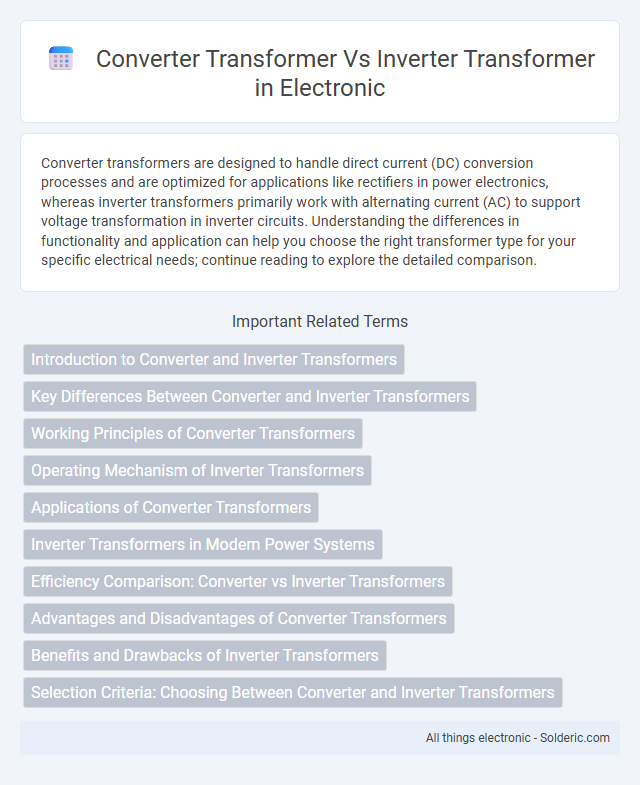Converter transformers are designed to handle direct current (DC) conversion processes and are optimized for applications like rectifiers in power electronics, whereas inverter transformers primarily work with alternating current (AC) to support voltage transformation in inverter circuits. Understanding the differences in functionality and application can help you choose the right transformer type for your specific electrical needs; continue reading to explore the detailed comparison.
Comparison Table
| Feature | Converter Transformer | Inverter Transformer |
|---|---|---|
| Primary Use | Converts AC to DC in rectifier circuits | Converts DC to AC in inverter circuits |
| Operating Frequency | Low frequency (50/60 Hz) | High frequency (kHz range) |
| Core Type | Silicon steel laminated core | Ferrite or powdered iron core |
| Size and Weight | Larger and heavier due to low frequency | Smaller and lighter due to high frequency |
| Efficiency | High at low frequency | High at high frequency with reduced losses |
| Applications | Power rectifiers, HVDC converters | Renewable energy inverters, UPS, motor drives |
| Voltage Transformation | Step up or step down AC voltage before rectification | Transforms voltage during DC to AC inversion |
Introduction to Converter and Inverter Transformers
Converter transformers are designed specifically for converting AC power to DC, commonly used in rectifier applications where they provide galvanic isolation and voltage transformation. Inverter transformers operate in inverter circuits, converting DC back to AC with controlled frequency, enabling efficient power conversion in applications such as renewable energy and motor drives. Your choice between these transformers depends on the direction of power conversion and the specific voltage and frequency requirements of your system.
Key Differences Between Converter and Inverter Transformers
Converter transformers are specifically designed for converting alternating current (AC) to direct current (DC) in high power applications such as HVDC transmission, featuring high harmonic tolerance and robust construction. Inverter transformers, on the other hand, are optimized for converting DC back to AC at variable frequencies in renewable energy systems and motor drives, enabling efficient and flexible power output. Your choice depends on the application requirements, focusing on harmonic management, voltage levels, and frequency control capabilities.
Working Principles of Converter Transformers
Converter transformers operate by facilitating the conversion of AC voltage to DC voltage or different AC frequencies through rectification processes, supporting devices like HVDC systems and variable frequency drives. Their core design includes features such as high short-circuit strength and specific winding arrangements to handle the DC components and harmonic currents produced during conversion. In contrast to inverter transformers, which convert DC back to AC, converter transformers are optimized to manage the direct current load and ensure stable power transfer within converter stations.
Operating Mechanism of Inverter Transformers
Inverter transformers operate by converting direct current (DC) into high-frequency alternating current (AC) using semiconductor switches, which enables efficient voltage transformation with minimal losses. Unlike conventional converter transformers that handle low-frequency or standard AC signals, inverter transformers rely on high-frequency switching circuits to achieve compact size and rapid response. This mechanism allows inverter transformers to be key components in power inverters, uninterruptible power supplies (UPS), and renewable energy systems for effective voltage regulation and energy conversion.
Applications of Converter Transformers
Converter transformers are primarily used in high-voltage direct current (HVDC) transmission systems, industrial motor drives, and electrochemical processes where AC power is converted to DC. These transformers handle DC current harmonics and provide isolation, voltage transformation, and fault protection in rectifier and inverter circuits. Their robust design supports applications in renewable energy integration, aluminum smelting, and rail traction systems requiring precise power conversion.
Inverter Transformers in Modern Power Systems
Inverter transformers play a crucial role in modern power systems by efficiently converting DC to AC power with high frequency, enabling compact and lightweight designs. These transformers support renewable energy integration, motor drives, and uninterruptible power supplies by providing precise voltage regulation and minimizing harmonic distortion. Their ability to operate at higher frequencies improves energy efficiency and reduces electromagnetic interference compared to traditional converter transformers.
Efficiency Comparison: Converter vs Inverter Transformers
Converter transformers typically achieve higher efficiency in AC to DC conversions by minimizing power loss through direct rectification methods. Inverter transformers, designed for DC to AC conversion, often experience efficiency losses due to switching frequencies and harmonic distortions. Efficiency rates for converter transformers generally range from 95% to 98%, whereas inverter transformers usually operate within 90% to 96%, depending on design and application.
Advantages and Disadvantages of Converter Transformers
Converter transformers provide efficient voltage transformation and electrical isolation specifically designed for rectifier circuits in power conversion systems. Their ability to handle high harmonic currents and provide phase-shifted outputs minimizes harmonic distortion, enhancing power quality and system stability. However, converter transformers tend to be more expensive, larger, and require specialized cooling systems compared to inverter transformers, and they may experience increased losses due to harmonic heating under nonlinear load conditions.
Benefits and Drawbacks of Inverter Transformers
Inverter transformers offer benefits like compact size, lightweight design, and improved efficiency due to high-frequency operation, making them ideal for portable and sensitive electronic devices. They also provide better voltage regulation and reduced electromagnetic interference compared to traditional converter transformers. Your choice of inverter transformers should consider drawbacks such as higher manufacturing costs, complexity in design, and potential challenges in handling high power applications.
Selection Criteria: Choosing Between Converter and Inverter Transformers
Selecting between converter and inverter transformers depends primarily on the application's frequency and voltage requirements, where converter transformers suit low-frequency, high-current environments, especially in DC conversion systems. Inverter transformers are optimized for high-frequency operation in AC to AC or DC to AC conversions, offering compact size and higher efficiency ideal for renewable energy and motor drive applications. Evaluating load type, harmonic distortion, and thermal performance further refines the transformer choice to ensure compatibility and operational reliability in power electronic systems.
converter transformer vs inverter transformer Infographic

 solderic.com
solderic.com